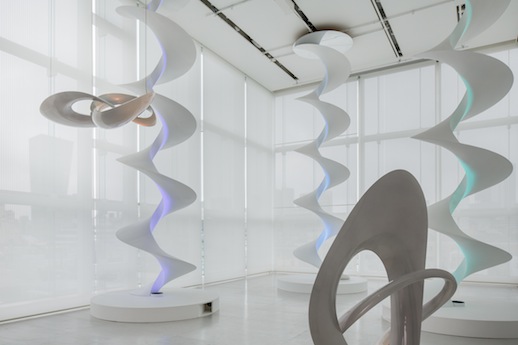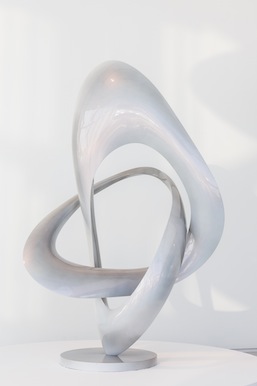Rebirth and Infinity

It could be easy to assume that beyond the museums, Tokyo would be an unlikely city to find large-scaled installation art. Better known for its scarcity of space than its abundance of roomy interiors, it might also be expected that this would prevent larger works from being created initially. And whilst these limitations do apply to some galleries, this assumption isn’t true for all. Espace Louis Vuitton Tokyo is one such gallery and just opened is “Infinite Renew” by Mariko Mori.
Beginning on the ground floor is a tall monitor displaying a pale, animated piece entitled Alaya (2013). At two minutes and 30 seconds, it’s a brief but delicately drawn work that depicts pastel coloured organic cells separating from one another before gently floating across the surface of the screen. Each form is protected within a pod of translucent gel, each traversing an unknown white void. After about a minute, hundreds of these forms are shown to be sharing the same horizontal plane, revealing a galaxy of globules clustered around or journeying toward a haloed sun. Referring to part of the Eight Consciousnesses in Buddhism by title, it serves as an apt introduction to the exhibition, one that unifies the micro with the macro and establishes Mori’s on-going subjects – rebirth and infinity.
The main exhibition space on the seventh floor displays seven more works. All but one are presented on plinths, some seem to reach beyond the lofty ceiling of the double-height gallery, while one is suspended by thread above you, causing graduated geometric shadows to be cast on the adjacent wall. From floor to ceiling, all is white.
Renew I (2013) is the first piece in the gallery, made of an almost-white Möbius strip, or twisted cylinder, with a faintly pearlescent finish that stands about two metres tall. Looping around and back on itself, its width narrows and broadens irregularly, resting on an edge so thin that it seems improbable that it could support the weight of the entire sculpture. Following its twists, it becomes apparent that it is a riddle of form. Originally discovered during the nineteenth century by two German mathematicians, an individual Möbius strip consists of a single, continuous surface that loops unendingly. Made without visible joins, this work’s production process is concealed; negating its own assembly. Was it made or has it always been?

Infinite Energy I, II and III (2013) are works that visitors can affect. Installed asymmetrically, they appear independent of the buildings structure. Using the full, eight-metre height of the space are three cyclonic coils that extend toward circular mirrors positioned on the ceiling, their illusory ascent assured beyond Espace’s upper limits. Should you arrive before other visitors, you’ll see these spirals as pure white, each with a texture like unglazed porcelain. But as you approach them they respond to your presence. Lights on their bases pulse bright beams of magenta, ultramarine and emerald, illuminating the curvature of the coils and alternating in accordance with your movements.
It’s not the first time that Mori has used light as a sculptural element. Most impressively, she created the monument Tom Na H’iu (2010) on Teshima Island. Connected to Kamioka Observatory, it responds to the events of a prehistoric sky. Every time a supernova explodes, signalling the death of a star, light emanates from the sculpture to signify the cycle of life, death and rebirth. In Tom Na H’iu (2010) she combined the mysteries of ancient monoliths with the answers of contemporary technology to create a metaphor for reincarnation.
The Infinite Energy installation sees Mori shifting iconic forms. It’s the first occasion she’s employed the spiral motif as a sculptural form and it’s the first time that she’s produced works that directly respond to events in their immediate proximity. Like DNA strands tethered together, they continue her enquiry, this time along anthropomorphic lines, reflecting our structure and our actions instead. Her work often pares down to certain essentials. Colourlessness, transparency and light are frequent visual attributes, whilst eggs, pods and stones are recurrent physical forms. “Infinite Renew” continues with many of these but emphasises light as a flow of energy. “It is an endless renewal of invisible energy, a regenerating force for life”1.
1. Mariko Mori in the exhibition catalogue for “Infinite Renew”.
Nick West
Nick West



